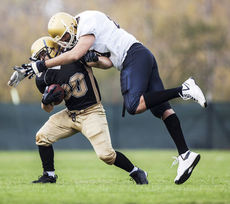By Spartanburg Regional Healthcare System
A football player takes a hard blow to the head during a game. Feeling dizzy and slightly nauseous, he continues playing, not aware that he’s feeling the classic symptoms of a concussion.
This is a common scenario physicians have worked to change over the last 10 to 15 years, according to Dr. John Lucas, who is Medical Group of the Carolinas Sports Medicine Institute physician.
“Ten years ago, if you took a hit to the head and you were a little bit dazed a few seconds, you may have been told to get up and shake it off,” Lucas said. “Now, we are a lot more serious of how we define and treat concussion. The medical community has really pushed to get people to understand both the immediate and potential long-term implications of head injuries.”
A concussion is a type of head injury that affects the way the brain functions. Symptoms of a concussion vary but may include a headache or pressure in the head, temporary loss of consciousness, confusion, dizziness, ringing in the ears or nausea. You do not have to lose consciousness to have a concussion, which is a common misconception.
“For the most part, the treatment of concussion is and has always been rest,” Lucas said. “Approximately (80) percent of concussions resolve within seven to 10 days without any intervention. What used to be called ‘getting your bell rung’ is now defined as concussion. There are no "dings" anymore. I definitely think we have broadened what we define as concussion.”
What happens when hit in the head
A typical concussion involves an athlete being struck directly on the head or in the body causing the head to shake.
The athlete should report symptoms and be removed from play for further evaluation. Standard concussion testing and a neurologic exam should be performed to confirm the diagnosis and to rule out more concerning injuries such as a brain bleed. Certified athletic trainers are often on site of high school sports in South Carolina and are proficient in recognizing the signs and symptoms of concussion as well as red flag symptoms that warrant immediate evaluation. If no medical personnel are on site, it is best to be seen by a medical provider as soon as possible.
“In terms of treatment, initially I need to see the patient and perform a thorough neurological exam to make sure his or her symptoms are not related to more ominous conditions such as a brain bleed,” Lucas said. “Once I have determined the athlete has a normal neurologic exam, I will make academic accommodations to allow them to attend school without worsening symptoms. Sometimes, I withhold students from school for a period of time to allow their symptoms to improve. I also discuss other issues such as driving.”
To get back to the sport, symptoms have to resolve completely. The athlete is then progressed through a graded “return to play” progression. Medications can also be used to control debilitating or persisting symptoms as well as vestibular therapy for those with vestibular dysfunction.
Concussion controversy
As concussions have been redefined, controversies have emerged, even debating the exact definition of a concussion.
“In layman’s terms, a concussion can be defined as symptoms that develop from an injury that causes the brain to quickly shake or shift within the skull,” Lucas said. “There is still a lot of misunderstanding of what a concussion is. By today’s definition, any symptom that develops following an injury to the head should be evaluated.”
There is also intense debate over the long-term effects of repetitive head trauma. The movie “Concussion,” starring Will Smith and Alec Baldwin, focuses on the discovery by a neuropathologist, Dr. Bennet Omalu, — played by Smith, of a protein in the brains of NFL athletes called tau.
“This disease process is called chronic traumatic encephalopathy or CTE. This same protein is commonly found in other neuro-degenerative diseases such as Parkinsons. In the 1970s and 1980s, concussions were largely neglected by many medical professionals,” Lucas said.
“When Dr. Omalu brought to light his discovery of abnormal protein deposits in the brains of NFL athletes, there was pushback by the NFL establishment. The suspicion is that the NFL neglected emerging evidence of repetitive brain trauma. Of course, there are two sides two every story, but most would agree the NFL could have and should have been more proactive in how it handled athletes with concussions.
As for the new film covering concussions, while it may help heighten awareness of the seriousness of concussions, Lucas doesn’t advise taking advice from Hollywood.
“There is a lot of debate about the high rate of CTE we are finding in NFL athletes,” Lucas said. “There is not conclusive evidence to date that concussions will cause long-term damage to the brain. While Dr. Omalu’s autopsies have definitely made us more cautious about the possible implications of recurrent head trauma, I would like to make it clear that there is not clear evidence that repetitive head injuries equal CTE.”
